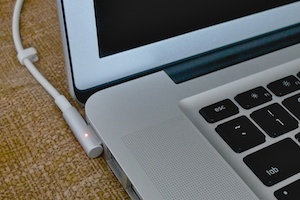MacBook Pro i7: worth the wait


Benchmarks are outstanding (as previously noted), but adding a Solid State Drive (SSD) makes the new MBP feel ridiculously fast. I moved the Runcore Pro IV SSD from my previous MBP to the new i7 chirpster and it feels even faster.
Migrating from my 3.06GHz Core 2 Duo couldn't have been easier: I simply moved the SSD into the i7, booted from the included media by holding down the "C" key and installed 10.6.3 over top. It takes about an hour, plus about another half hour (give or take) for all the updates from Software Update.
Word to the wise: don't forget to deactivate Adobe Creative Suite and to deauthorize iTunes before you pull your HDD/SSD. iTunes purchases can be used on up to five computers, and that can always be reset from the application if you've exceeded the cap, but if you forget to deactivate Creative Suite you have to call Adobe tech support to deactivate and activate remotely.
Inertial scrolling is a nice touch that I find myself liking more that I expected. It's useful for two-finger scrolling on long Web pages and documents and it's great for scrolling through long drop-down lists of choices. This feature isn't (currently) available on the Core 2 Duo MacBook Pros, although third-party software allows those user to add similar functionality.
The optional, 1680-by-1050 high-resolution antiglare display (an extra $150) is alone worth the price of admission. Nothing is worse that paying $2,000+ for a notebook computer that you can't use outdoors during daylight. The antiglare machines sport a cool aluminum bezel (pictured) as opposed to the glareBook's black glass bezel.
The new MacBook Air-like MagSafe power connector (also pictured) has been changed in the new i5/i7 machines but it blocks the Ethernet and Firewire ports when flipped forward. Hopefully the new barrel-style connector helps cut down on the fraying that I experienced on the last few MagSafe connectors. Apple would have done better by putting little bit of extra space between the USB ports.
Since 4GB of RAM is sufficient for most applications (and because upgrading to 8GB currently costs $400 from Apple, $500 from Crucial) I'll probably stick with 4GB until prices come down a little. If you've found cheaper DDR3 PC3-8500 options, post them in the TalkBack below.
Once my SSD was installed and its software updated, I replace Apple's weak "SuperDrive" with a Western Digital Scorpio Blue 750GB HDD in an Optibay enclosure cranking the storage in this speed demon up to 1TB. You can go up to 2TB by installing two 1TB mechanisms, or my favorite, 1.5TB via one 1TB HDD and one 512GB SSD. But keep in mind, at higher SSD capacities your cost per MB increases dramatically.
Lastly, if you've purchased a new MacBook, don't forget to calibrate the battery
The battery needs to be recalibrated from time to time to keep the onscreen battery time and percent display accurate and to keep the battery operating at maximum efficiency. You should perform this procedure when you first use your computer and then every few months after that.
...and don't leave it plugged in 24/7.